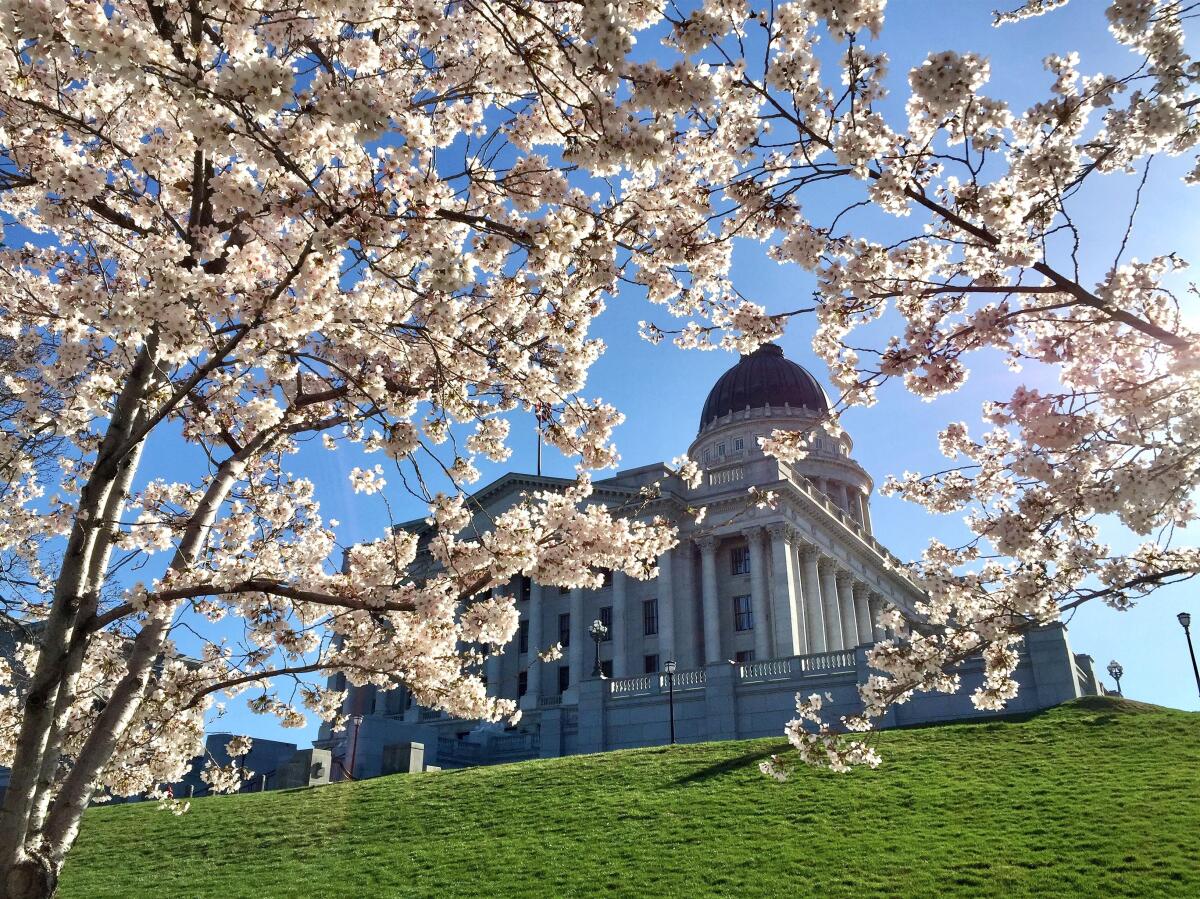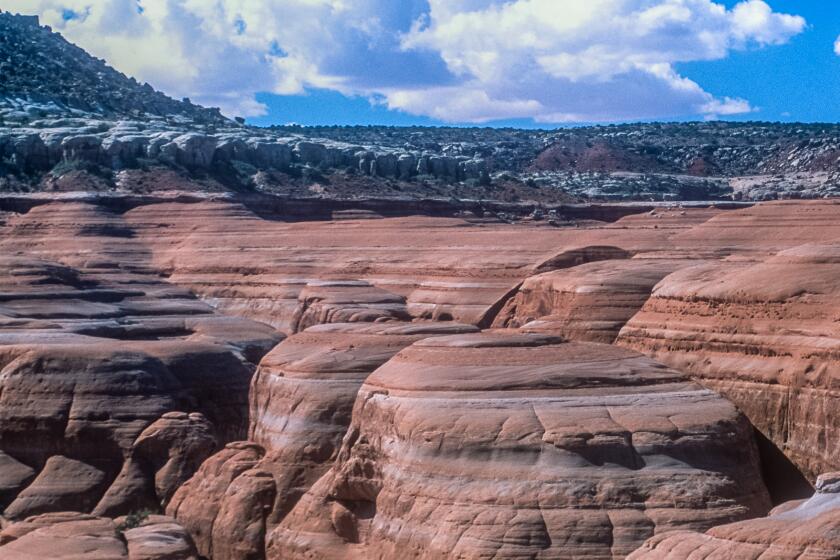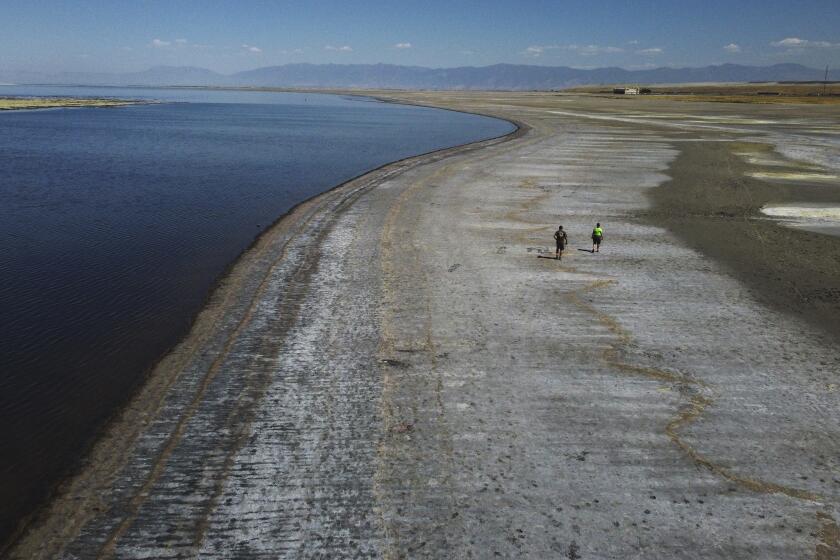In Utah, the Capitol really is the people’s house

- Share via
Many state capitol buildings feel unapproachable, tucked away downtown or barricaded behind lanes of noisy traffic. Not so in Salt Lake City. The Utah Capitol sits at the mouth of a verdant canyon, flanked by parks and neighborhoods, perched below the Wasatch Mountains and presiding over the city with authority. It’s a grand building, just over a century old, with a copper-clad dome and a neoclassical design that mirrors the U.S. Capitol.
Inside, the state Legislature convenes every January for 45 days. In deeply conservative Utah, the Republican supermajority passes one law after another that outrages progressives, educators, young people and more. Outside the walls, these marginalized groups protest these same bills.
Ten years ago, my wife and I moved a block away from this stately old building, serendipitously finding our new home an easy launchpad to attend rallies. The stack of homemade signs accumulating in our basement testifies to our proximity.
In January 2017, we joined 6,000 Utahans in the Capitol rotunda — 1,000 more than the official capacity of the space — for the existential roar of the Women’s March.
The following December, President Trump came to Utah to sign an executive order eviscerating the state’s two newest national monuments, Bears Ears and Grand Staircase-Escalante. We watched his entourage arrive in ominous black SUVs, channeled into the Capitol’s underground garage by rows of sand-filled dump trucks blocking our neighborhood streets. The ceremony inside was invitation-only. Out on the Capitol grounds, we chanted with thousands of protesters.
Utah’s anti-Washington politicians keep trying to make our beloved parks, monuments and wilderness their own
In the tumultuous years that followed, crowds approaching 10,000 people have gathered repeatedly on the South Lawn, at the front door of their government. Demonstrations come in all flavors. When Argentina won the 2022 men’s World Cup, where were hundreds of delighted soccer fans gathering? At the Capitol, of course.
As protesters and counter-protesters increased following the 2016 election, Capitol police — Utah Highway Patrol officers — ramped up security. Burly pickups regularly circle aggressively, flying Trump flags. Their occupants, wielding assault weapons (legally), stand at the edges of crowds. On Jan. 6, 2021, several hundred people rallied to “Stop the Steal.” A Salt Lake Tribune photographer got pepper-sprayed and taunted for wearing a mask.
At the same time, says Capt. Greg Holley, who leads the Capitol officers, you could “see people having a picnic and throwing a Frisbee for their dog.” He considers his job as “not just an assignment but a privilege.”
It’s remarkable how open the building is; there are no metal detectors most of the year. You can walk in and revel in the enormous space under the dome. Administrators do have to deny permits to wedding couples with especially creative ideas: no ziplines in the rotunda.
People visit the grounds at all hours. So do deer, moose, raccoons and coyotes. The troopers take care to avoid the nesting great horned owls that return each year and “swoop” patrolling officers if they shine lights toward their perches.
Salt Lake City’s namesake is evaporating, and with it a resource crucial to the West’s economy, weather and health — not to mention millions of migratory birds.
In pre-COVID years, tourists wielding selfie sticks regularly poured out of buses as early as 7 a.m. Post-pandemic, that steady stream hasn’t returned. But later in the day, things pick up. Summer yoga classes attract hundreds, mats laid out across the South Lawn. Beaming young women pose in spectacularly vivid quinceañera dresses. Families throng an oval walkway in spring when cherry trees hit peak blossom.
The density of larger trees scattered across graceful expanses of grass dropped sharply when a tornado hit the city in 1999, taking out 90 trees; a hurricane-force windstorm toppled still more in 2020. A massive 2008 restoration project spruced things up and placed the entire building on rubber earthquake pads. When a 7.0 quake comes — as it surely will, here on the Wasatch Fault — the Capitol should be able to weather the jolt by shimmying up to two feet from side to side on those “isolators.”
The 42 acres of grounds — designed in 1909 by the stepson of Frederick Law Olmsted — host a cast of regulars. The bubble guy, who wafts huge iridescent spheres across the lawn. The skateboarding French bulldog. The nearly naked runner who wears only light running shorts and a Go-Pro, year-round. We are consistently surprised by the pageant.
One Sunday we found Corey “Thunder” Law of the Harlem Globetrotters on the Capitol’s stone terrace directly below a basketball hoop suspended from a crane. He was skyrocketing his ball over and over, trying for the Guinness World Record “highest upward basketball shot.” He got it: 50 feet, 1 inch, on Nov. 5, 2017. You can look it up.
Another time, we saw golden showers of sparks twirling like giant butterflies above the building. Mystified, we walked over to the grounds and discovered wingsuiters outfitted with pyrotechnics parachuting onto the Capitol lawn to promote the Nitro World Games. We watched, bug-eyed, with another couple who turned out to be then-Gov. Gary Herbert and his wife, Jeanette, just as amazed as we were.
L.A. is building a hydrogen plant in Utah — yes, Utah — but will it actually produce clean energy?
It’s a low-key state. But a complicated one. Nowhere are those complications more on display than at the Capitol.
Salt Lake City poet Nan Seymour led a Great Salt Lake vigil here during the 2024 legislative session. Every morning, volunteers circled the Capitol carrying blue and white fabric waves, pausing to face west toward the lake in prayer. Every afternoon, suited up in bird and brine shrimp costumes, the vigil-keepers danced. Were legislators listening? They have yet to act to restore the endangered Great Salt Lake.
Olivia Juarez found their voice here this year. They had attended a Capitol rally for clean air while studying at the University of Utah, finding a sense of community in this place “where people cared about the same issues that I did. As I watched and listened, I thought, I want to do that someday, at that podium.” They did just that, chanting, singing and defending the Great Salt Lake for “under-represented people like me.”
Juarez shared the podium with another fierce millennial activist, Lauren Wood. “Many view the power coming from legislators within the building, I’d argue the opposite,” Wood told me. “The Capitol really is ‘the people’s house.’ And if you want to speak to the people of Utah, you’d be hard pressed to pick a better pulpit.”
Stephen Trimble is the author of “The Sagebrush Ocean: A Natural History of the Great Basin.”
More to Read
Updates
8:52 a.m. April 12, 2024: An earlier version of this piece misspelled Frederick Law Olmsted’s name; his stepson, not his sons, designed the grounds of the Utah Capitol. The waves carried by protesters were made of fabric, not paper.
A cure for the common opinion
Get thought-provoking perspectives with our weekly newsletter.
You may occasionally receive promotional content from the Los Angeles Times.












